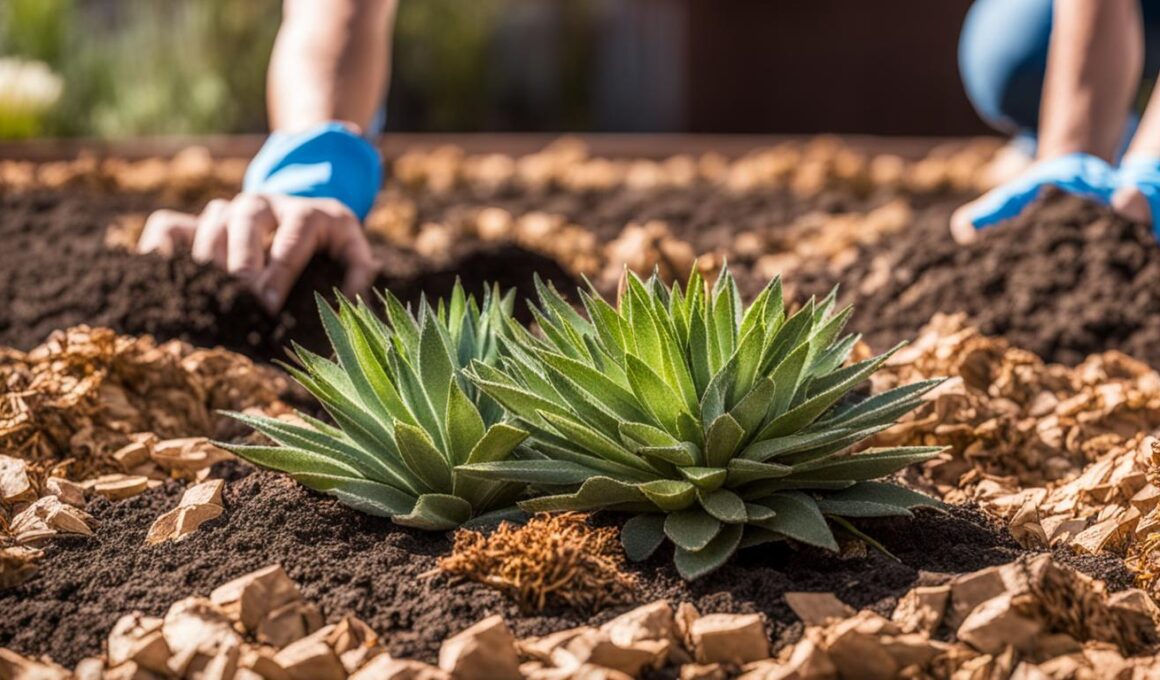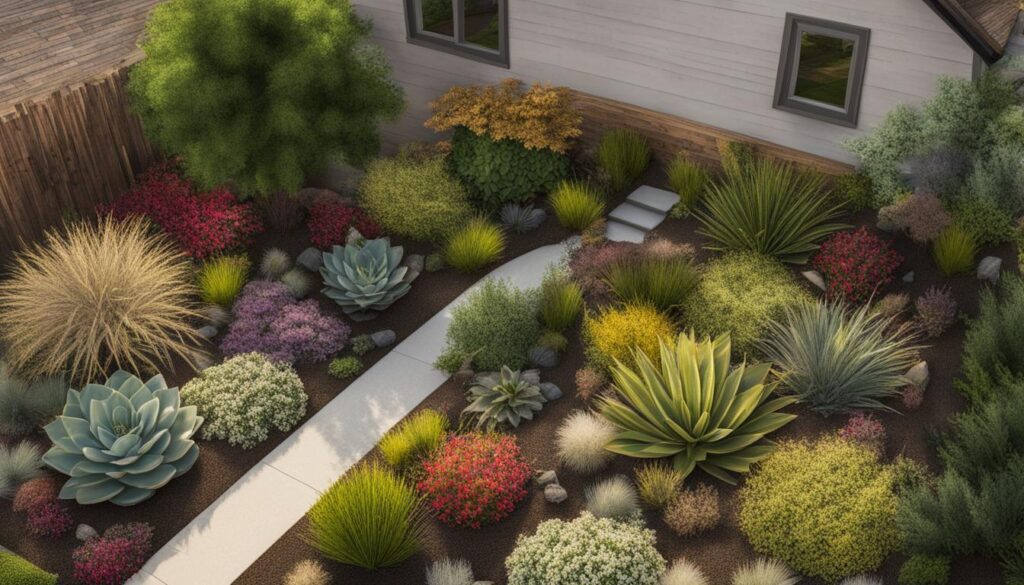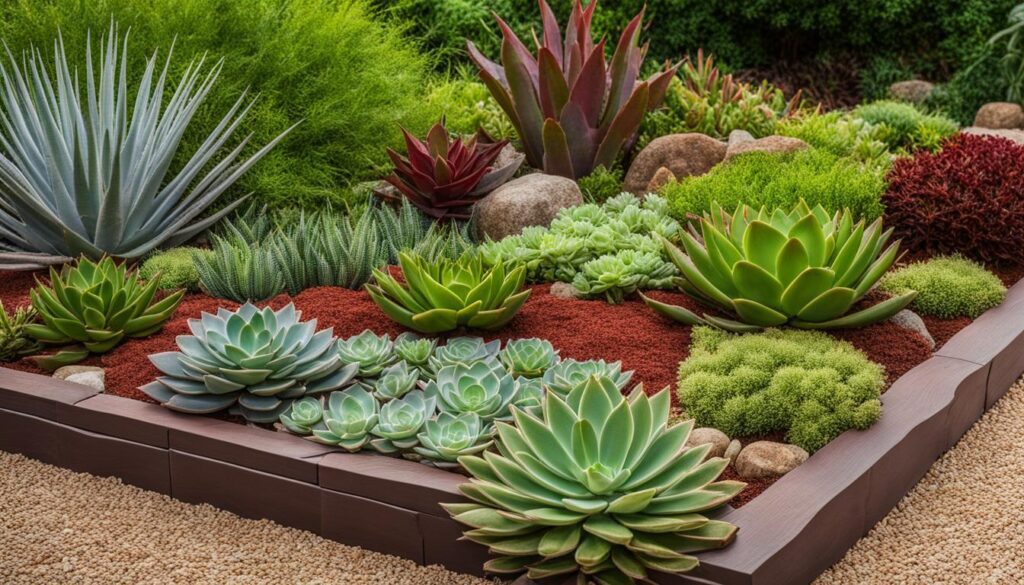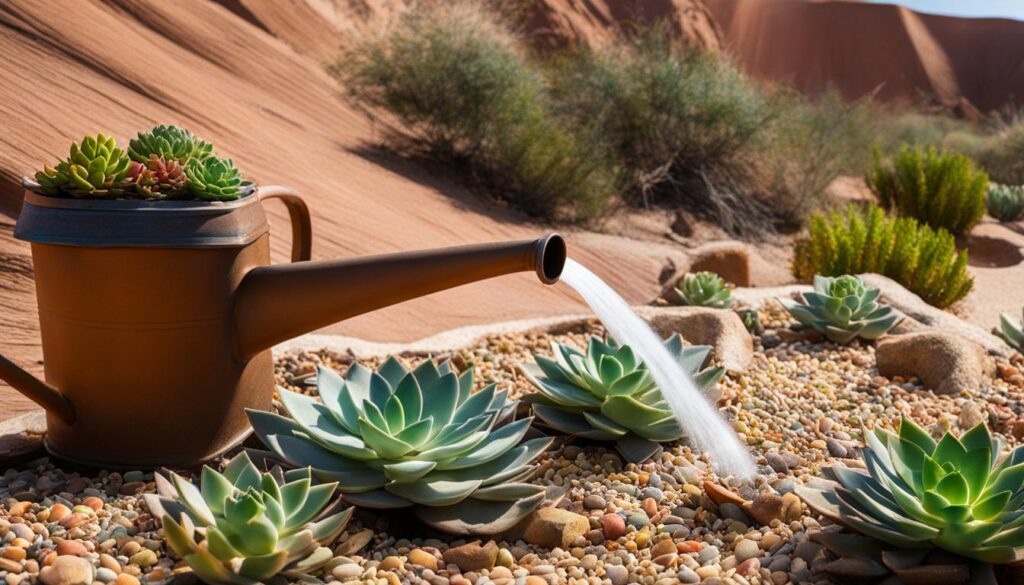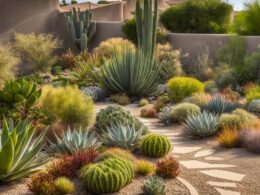Xeriscaping is an innovative gardening approach that focuses on water conservation techniques to create a stunning and eco-friendly yard that can thrive even in drought conditions. By combining xeriscaping methods with square foot gardening, you can maximize your space, yield, and minimize water usage. One essential aspect of xeriscaping is proper mulching techniques, which play a crucial role in reducing evaporation, preventing weed growth, and maintaining soil moisture levels. By mastering the art of mulching, you can create a low-maintenance, drought-tolerant yard that is not only visually appealing but also environmentally sustainable.
Key Takeaways:
- Mulching is a vital component of xeriscaping for a drought-tolerant yard.
- Proper mulching techniques help reduce evaporation and maintain soil moisture levels.
- Mulching prevents weed growth, minimizing the need for chemical interventions.
- By applying mulch at a proper depth, you can create a visually appealing and low-maintenance garden.
- Mastering mulching techniques is crucial for water conservation and promoting environmental sustainability in your xeriscape garden.
What is Xeriscaping and Square Foot Gardening?
Xeriscaping is a gardening method that focuses on water conservation by implementing various techniques such as using mulch, reducing fertilizers, planting drought-tolerant plants, installing efficient irrigation systems, and collecting rainwater. It is a sustainable landscaping approach that aims to create a beautiful, eco-friendly yard while minimizing water usage. By incorporating square foot gardening into xeriscaping, you can maximize the productivity of your garden in a smaller space.
Square foot gardening is an intensive gardening style that utilizes raised beds divided into one-foot by one-foot squares. This method helps in efficient space utilization and better control of plant growth. Each square can be dedicated to a specific plant or crop, allowing for easy maintenance and minimal waste of resources. The combination of xeriscaping and square foot gardening is a powerful approach to create a drought-tolerant yard that maximizes yield while promoting water conservation.
Benefits of Xeriscaping and Square Foot Gardening
- Water Conservation: Xeriscaping and square foot gardening techniques help reduce water consumption significantly by optimizing plant selection, soil moisture retention, and irrigation methods.
- Efficient Space Utilization: Square foot gardening allows you to grow a variety of plants in a limited space, making it ideal for small gardens or urban areas.
- Low Maintenance: Xeriscaping and square foot gardening minimize the need for watering, weeding, and the use of chemical fertilizers, resulting in a low-maintenance yard that saves time and effort.
- Eco-Friendly: By reducing water usage and eliminating the need for chemical inputs, xeriscaping and square foot gardening promote environmental sustainability and protect natural resources.
By implementing these water conservation techniques in your yard, you can create a beautiful and productive garden that thrives even in drought conditions while contributing to a greener and more sustainable environment.
Benefits of Xeriscaping for a Drought-Tolerant Yard
Xeriscaping offers numerous benefits for creating a drought-tolerant yard. This sustainable landscaping method helps conserve water and reduce water usage, making it environmentally friendly. By incorporating xeriscaping techniques into your yard, you can significantly reduce your water bill while still maintaining a beautiful and thriving landscape.
One of the key benefits of xeriscaping is its ability to reduce the need for pesticides and fertilizers. By choosing drought-tolerant plants and grouping them according to their water needs, you can minimize the use of chemicals and promote a healthier garden. This not only benefits the environment by reducing pollution but also creates a safer outdoor space for you and your family.
Preserving Water Resources
“Xeriscaping allows you to conserve water without sacrificing the beauty of your yard.”
In addition to reducing chemical use, xeriscaping helps preserve water resources by minimizing evaporation and runoff. By mulching the soil surface, you create a barrier that reduces water loss through evaporation and keeps the soil moist for a longer period. This, coupled with proper watering techniques and efficient irrigation systems, ensures that water is used efficiently and effectively.
Furthermore, by selecting drought-resistant plants that are well-suited to your local climate and soil conditions, you can reduce the amount of water needed for irrigation. These plants have evolved to thrive in arid environments, making them more resilient and less dependent on regular watering. By implementing xeriscaping techniques, you can create a visually appealing and low-maintenance yard that conserves water and promotes sustainability.
- Conserves water and reduces water usage
- Reduces the need for pesticides and fertilizers
- Minimizes evaporation and runoff
- Preserves water resources
- Promotes a visually appealing and low-maintenance yard
By taking advantage of the benefits of xeriscaping, you can create a beautiful and sustainable yard that can withstand drought conditions. Whether you live in an arid climate or simply want to reduce your water consumption, xeriscaping offers a practical and eco-friendly solution. So, start implementing xeriscaping techniques in your yard today and enjoy the benefits of a drought-tolerant landscape.
Planning and Design in Xeriscaping
When it comes to creating a successful xeriscape garden, proper planning and design are essential. By taking the time to assess your site’s topography, exposure, and soil conditions, you can make informed decisions about the layout and plant selection for your drought-tolerant yard. Start by identifying areas of your yard that receive different levels of sunlight and shade throughout the day. This will help you determine which plants are best suited for each area.
Grouping plants based on their water needs is another key aspect of xeriscape planning. By clustering plants with similar water requirements together, you can create efficient watering zones and minimize water usage. Consider using drought-tolerant native plants, as they are well-adapted to the local climate and typically require less maintenance. These plants have evolved to thrive in your area and are more resistant to pests and diseases.
Soil preparation is also a critical step in xeriscaping. Incorporating organic matter, such as compost or well-rotted manure, into the soil can improve its ability to retain water and nutrients. This helps create an optimal growing environment for your plants and reduces the need for excessive watering.
Lastly, don’t forget to consider the aesthetic aspects of your xeriscape garden. Incorporating elements such as pathways, rocks, and decorative features can enhance the visual appeal of your yard while maintaining its water-wise design. By carefully planning and designing your xeriscape garden, you can create a beautiful and sustainable outdoor space.
Effective Mulching Techniques in Xeriscaping
Mulching is a key component of xeriscaping that helps conserve water and maintain soil moisture in a drought-tolerant yard. Applying the right mulching techniques can significantly reduce water usage and promote water conservation in your xeriscape garden. Here are some effective mulching techniques to incorporate into your xeriscaping practices:
1. Choose Organic Mulch
Using organic mulch, such as pine straw or pine bark, is highly recommended in xeriscaping. Organic mulch not only reduces evaporation but also improves soil structure and fertility over time. It acts as a protective barrier, preventing weed growth and slowing down moisture loss from the soil. Apply a layer of organic mulch with a depth of about four inches to maximize water retention and minimize the need for frequent watering.
2. Mulch Consistently
Mulch should be regularly checked and replenished to maintain its effectiveness. Over time, organic mulch can break down and decompose, losing its ability to retain moisture. Inspect your mulch layer every six months and add a fresh layer if necessary. Consistent mulching ensures that your xeriscape garden remains well-protected and adequately moist, even during dry spells.
3. Mulch Correctly
When applying mulch, make sure to leave a small gap around the base of plants to prevent moisture build-up and potential rot. Avoid piling mulch against the stems or trunks of plants, as this can create a favorable environment for pests and diseases. Spread the mulch evenly, extending it to the drip line of trees and shrubs to ensure maximum water retention and avoid water runoff.
Selecting Drought-Resistant Plants for Xeriscaping
When it comes to xeriscaping, selecting the right plants is crucial for creating a drought-tolerant yard. By choosing drought-resistant plants that are well-suited to your local climate and soil conditions, you can ensure the success of your xeriscape garden. Consider plants like rhubarb, sweet potatoes, summer squash, eggplants, and pole beans, which have proven to thrive in arid conditions.
Native plants are also a great choice for xeriscaping as they require less care and are better adapted to your area’s climate. These plants have evolved to withstand the challenges of local weather patterns and soil conditions, making them excellent candidates for water-wise gardening. By incorporating native plants into your xeriscape garden, you can reduce water usage while maintaining a visually appealing landscape.
Before selecting your plants, take into account the expected growing season conditions. Choose plants that are adapted to hot and dry weather or cool and damp conditions, depending on your region. This will ensure their resilience and improve their chances of survival in your xeriscape garden. Remember to also consider the overall aesthetics and design of your yard, creating a harmonious blend of colors, textures, and heights that complement each other.
By carefully selecting drought-resistant plants for your xeriscape garden, you can create a beautiful and sustainable landscape that thrives with minimal water usage. These plants, combined with effective mulching techniques and efficient watering methods, will help you achieve a drought-tolerant yard that not only saves water but also promotes a greener and more environmentally conscious approach to gardening.
Can Water-Saving Mulches Help with Mastering Mulching Techniques in Xeriscaping?
Water saving mulches for xeriscapes can definitely help in mastering mulching techniques in xeriscaping. These mulches not only help in conserving water but also protect the soil, suppress weeds, and regulate soil temperature. Choosing the right type of mulch can make a significant difference in xeriscaping efforts.
Watering Techniques and Irrigation in Xeriscaping
Efficient watering techniques and irrigation systems are essential in maintaining a drought-tolerant yard in xeriscaping. By following these practices, you can maximize water efficiency, promote healthy plant growth, and conserve water in your garden.
1. Timing is key: Water your plants between 9:00 p.m. and 8:00 a.m. to reduce evaporation. This allows the water to penetrate the soil and reach the plant’s roots before the heat of the day.
2. Install efficient irrigation systems: Consider installing efficient irrigation systems, such as drip irrigation. This method delivers water directly to the plants’ root zones with minimal loss. It ensures that the water is utilized effectively and not wasted through evaporation or runoff.
3. Collect rainwater: Make use of nature’s gift by collecting rainwater in barrels or storage tanks. You can use this water during dry periods to supplement your irrigation needs. This helps reduce the strain on groundwater supplies and promotes sustainable water usage.
4. Regularly test and amend your soil: It’s important to regularly test your soil’s moisture levels and amend it as needed to ensure proper water retention. Organic matter, such as compost, can be added to improve the soil’s ability to hold moisture, reducing the frequency of watering.
By implementing appropriate watering techniques and utilizing efficient irrigation systems, you can ensure that your xeriscape garden thrives while conserving water and promoting environmental sustainability.
Conclusion
Xeriscaping, combined with effective mulching techniques, offers a sustainable and water-wise approach to gardening. By implementing proper planning and design, selecting drought-resistant plants, and using efficient watering and irrigation methods, you can create a beautiful, low-maintenance, and eco-friendly xeriscape garden.
Mulching plays a vital role in xeriscaping by reducing evaporation, controlling weed growth, and maintaining soil moisture levels. By applying organic mulch, such as pine straw or pine bark, at a depth of about four inches, you can significantly reduce water usage and promote water conservation in your xeriscape garden.
With a well-designed xeriscape yard, you can enjoy the beauty of nature while minimizing your impact on the environment. By following these techniques and embracing the principles of xeriscaping, you can create a drought-tolerant yard that thrives even in dry conditions, while conserving water and promoting environmental sustainability.





